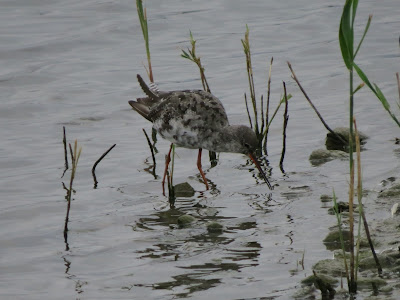With temperatures reaching the mid thirties, and with the school holidays bringing the rabble out I decided an early morning visit to Alton Water was in order. Getting up at 5:30 was an enormous undertaking for me, I like my lie-ins, and I ended up getting to the reservoir at around half six, through quiet traffic-less roads.
At this time of day every thing is beautiful. The air was mild and the water as still as a mill pond. There were no cars and no people around which was great, just me and the birds.
Bird watching at Alton Water is different to birding at some of the more popular reserves. At, say, Minsmere there is so much bird life that in any report I can't put in everything I see. This is the reverse of Alton Water where there is so little bird life I put in everything I see, so the reports seem the same length. Not every place is as good as Minsmere, but I have to explore the more general countryside, because birds aren't confined to one location. They are about everywhere, just not in as great numbers.
The scrubby grassy areas are good places for YELLOWHAMMERS
From the moment I got here and walked out along the causeway the most obvious bird was the COMMON TERN. There were plenty of these birds flying around, gliding over the water, before maybe occasionally dropping down with a splash to catch a fish. There were a lot around, and I took hundreds of photos, mainly of a white blur against an indistinct background.
Alton Water is a hard place to bird watch, as despite all the paths around there's not really much access to the water. There are two hides at the north shore, two on the south, overlooking different areas of water, and you have the causeway and the dam at either ends of the reservoir but that's it.
Rather than walk the entire length of the reservoir, there are a variety of car parks from where I was able to visit various look out points. Doing the circuit is only really viable if you have a bike, something I can't fit on my moped. Its still nice walking through the landscape of woodland, scrubby meadows, with various stops along the water.
The causeway - always the starting point for birding the water
The hides on the north shore, at this time of year, is where most of the bird life is concentrated. This is where the COMMON TERNS nest. Three shingle islands and several tern rafts have given the terns the perfect habitat to nest. There were plenty of chicks about so it seemed to be a decent breeding season. The adults would fly around the reservoir looking for fish before coming back to this area to feed their babies.
An adult TERN coming in to feed its waiting chick.
On the shingle islands areas of exposed mud attracted some WADERS, with two COMMON SANDPIPERS, one GREEN SANDPIPER and one OYSTERCATCHER present. This is a decent haul for an inland site in July.
The GREBE to the right had a little chick resting on its back. The grebe to its left came over to feed the chick, here with a fish.
Out on the water were various waterfowl, mainly GREAT CRESTED GREBES, with smaller numbers of COOT and TUFTED DUCK. These birds were mainly away from the main body of water, nestled in the various creeks. The birds especially kept away from the dam area as this is where the water sports take place, causing much disturbance. Bucking this were the EGYPTIAN GEESE, which seemed to be present everywhere, whether it be by the picnic site or in a secluded bay, they are very exotic although still somehow artificial at the same time. Maybe thirty were present.
PURPLE LOOSETRIFE growing amongst the reeds
The hides on the southern side were fairly quiet. A KINGFISHER flew past, seen briefly. From what I've heard from locals it seems that a pair is nesting in the area.
Around the picnic site, which has the centre, café and all sorts of facilities, were small numbers of birds. A SWAN brood of one was present, there was also a SWAN brood of five elsewhere on the reservoir, with a couple of moulting birds dotted around.
SWANS at the dam
Also present around there was an oversummering WIGEON, which is actually my first record of this species at this site, I did not expect to see one in July.
By the picnic site a BLACKBIRD would run down from the nearby bushes to bathe himself in the water.
Over by the dam, which is a large artificial wall to prop up the reservoir, few birds were present. There were a pair of OYSTERCATCHERS and a BLACK TAILED GODWIT flew over. Its always a quiet area as it tends to be busy with people.
Female KESTRAL resting on the reservoir overflow. At this time of year there is not much water, so the overflow is dry.
Well there you go a full species list for Alton Water. I was surprised as I did not expect to see this many birds, on a late July day at Alton Water. It just shows that birds are really present everywhere, you just have to be patient and you need to get up early.






























